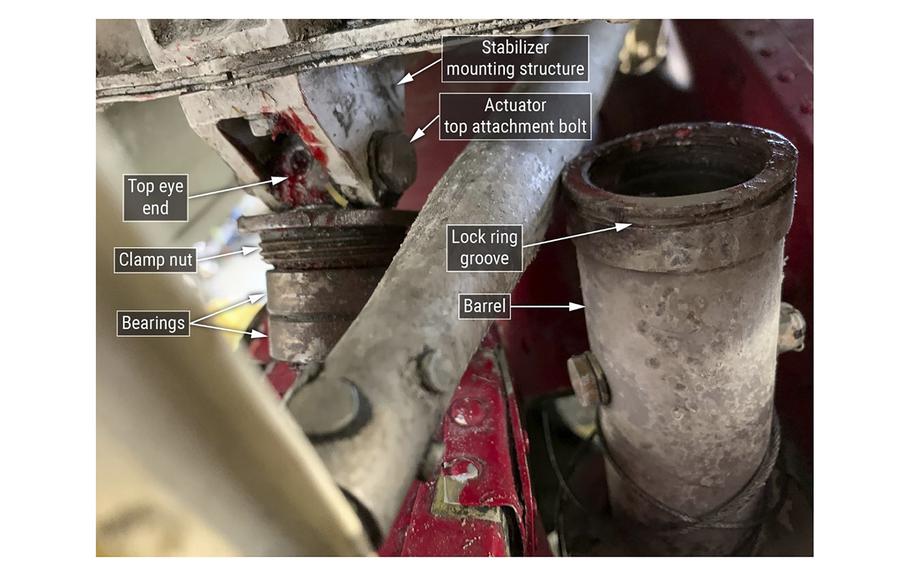
The actuator for the horizontal tail as retrieved from the September seaplane crash wreckage off Whidbey Island. The barrel of the actuator, right, connects to the flight controls. The actuator’s attachment to the tail, left, has a clamp nut that should fit inside the barrel. As shown, these two elements came apart, disconnecting the pilot controls from the tail. (NTSB/TNS)
SEATTLE (Tribune News Service) — Federal regulators Wednesday ordered seaplanes like the one that crashed off Whidbey Island be inspected for a flaw that likely caused the deadly September crash.
The Federal Aviation Administration airworthiness directive mandates that operators of all the DHC-3 Otter seaplanes in the United States — 63 of about 160 operating worldwide — examine the stabilizer to confirm the condition of an actuator piece missing from the Friday Harbor Seaplanes aircraft that fell into Mutiny Bay over Labor Day weekend. Ten people were killed in the crash.
According to the directive, operators must confirm that the stabilizer actuator lock ring is correctly installed and report back to the FAA by Dec. 19. The order does not ground the aircraft. Kenmore Air, the largest Otter operator on Puget Sound, said previously that its aircraft have passed inspection.
On Oct. 24, the National Transportation Safety Board, which is investigating the Sept. 4 crash, urged operators to ground all the planes in the fleet until the part is inspected, noting that it would be up to the FAA to issue any order to ground the plane. Last week, they doubled down, officially calling for the FAA to require inspection of the planes.
“We’re concerned that another plane could crash as a result of something similar,” NTSB Chair Jennifer Homendy said at the time. “Right now, the focus has to be (on) what could contribute to a further tragedy in the future.”
In an investigative update issued by the NTSB, the board identified a lock missing from the actuator of the horizontal tail — also known as a stabilizer — which controls the pitch of the airplane.
After crews recovered some 85% of the plane wreckage in September, investigators found the upper portion of the actuator was still attached to the horizontal stabilizer while the lower portion was “attached to its mount in the fuselage,” but disconnected.
While the NTSB has not officially deemed the actuator separation the cause of the crash, Homendy said the failure of the actuator could have caused the plane to plummet. Further accidents could occur if the lock pin is missing or improperly installed on other planes.
A spokesperson for the FAA said Wednesday that the directive was issued after the manufacturer, Viking Air Limited, issued a service bulletin. The FAA “began contacting DHC-3 operators in the United States to ensure they were acting on the recommended inspections” last week, the agency spokesperson said.
A problem with pitch control also would be consistent with the “nose dive” reported by dozens of onlookers who saw the plane hit Puget Sound.
Witnesses helped officials identify the crash site, search for survivors and locate the remains of one passenger in the immediate aftermath of the crash.
It took the NTSB and U.S. Navy crews more than a week and three types of sonar to locate what remained of the plane because of its depth and the current of the channel where the aircraft hit the water before fracturing beneath the surface. Remains of seven of the 10 people on board the flight have been located.
©2022 The Seattle Times.
Visit seattletimes.com.
Distributed by Tribune Content Agency, LLC.